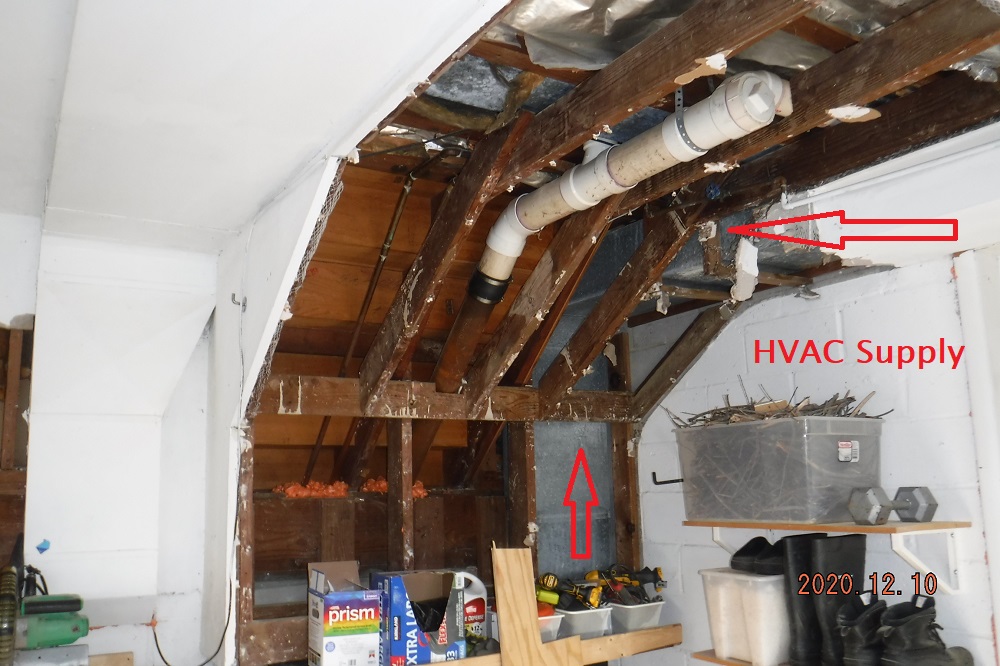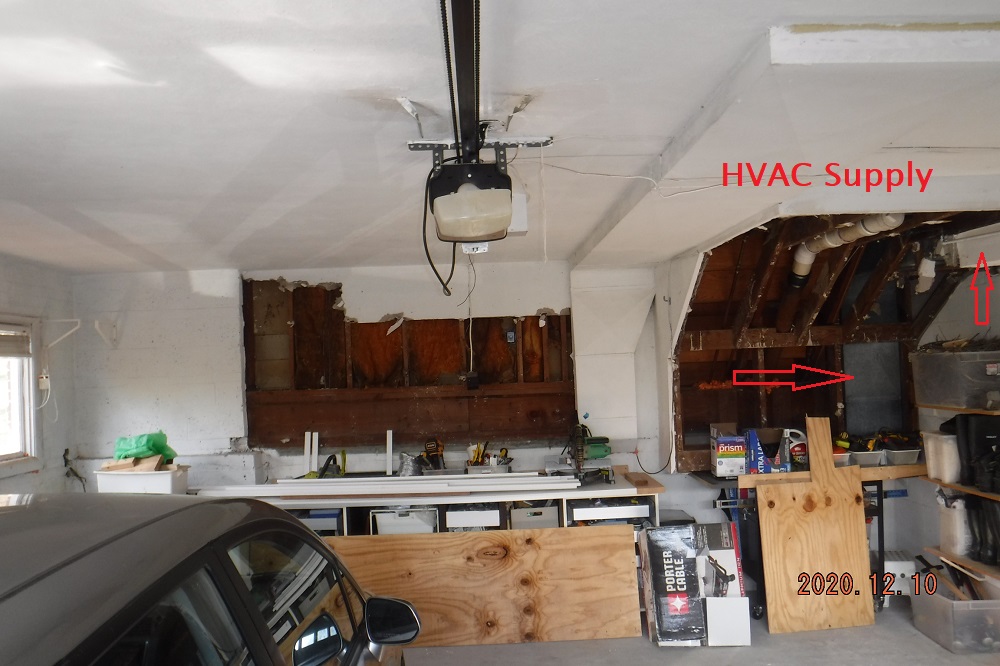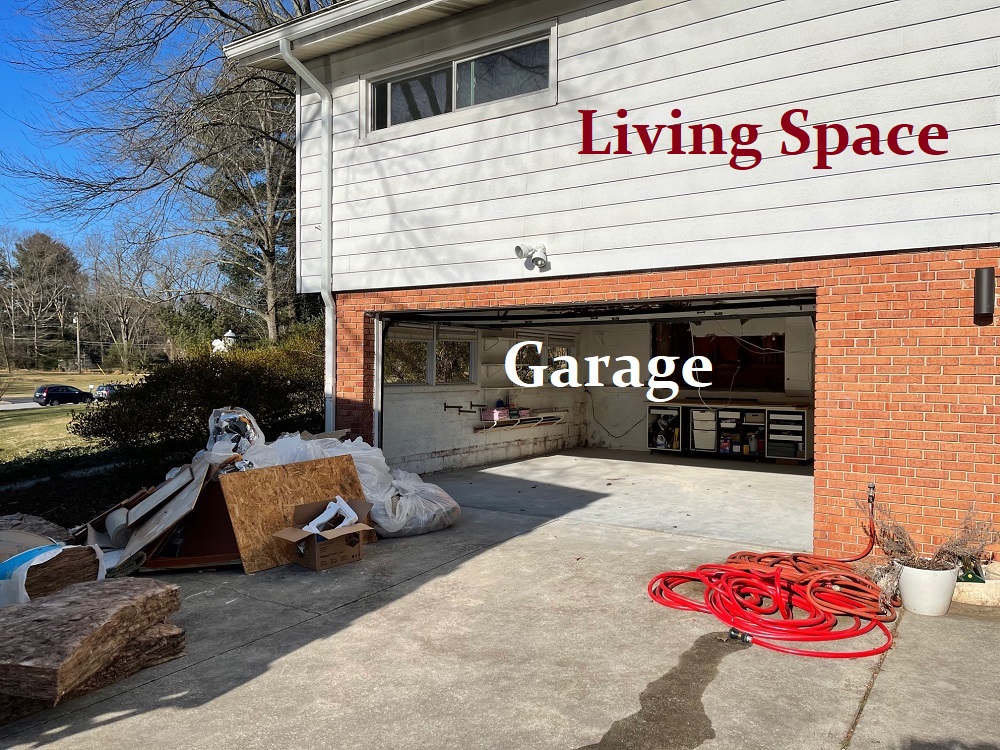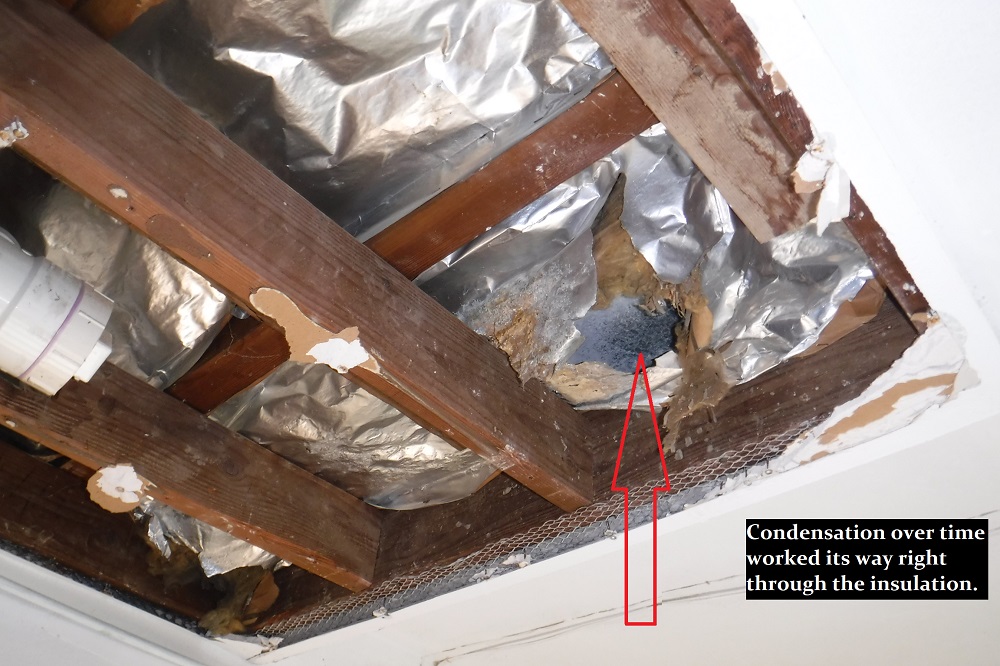Residential Comfort & Energy EfficiencySaturday, March 06 2021
And, yet despite their importance, they are often overlooked. Aside from the obvious, like making sure ducts are connected, there are other nuances that must be understood to prevent other potential issues. For example, leaky ducts in summer in the wrong location might lead to condensation resulting in water damage to ceilings or wood. This article will examine summer condensation issues related to ducts that run outside of the "envelope". This would include ducts that run through a garage (the focus of this post), crawl space, attic or cantilever also known as an overhang. Watch the Four Part Process First - Then Learn How it Came About Part 1 -The blank canvas. A fully removed plaster ceiling including the removal of nails and screws. The area beneath the ducts has been swept and protective platic has been installed to keep the area clean and neat for the customer once the project is completed. Part 2 -Application of the spray foam on the different areas of the HVAC supply plenum. During this portion of the video, the foam bonds to the duct and seals and insulates rapidly. Part 3 -Removal of excess insulation after it has fully cured. This is done in preparation for the drywall ceiling installation later in the week. Part 4 -A look at the completed portion of the duct sealing and insulation project to get a feel for the final product. Initially - I Was a Little Worried About this Project According to my eventual customer, the garage ceiling insulation project had already been contracted to be done and when the chosen company showed up to do the work, they promptly turned around and said it was too much for them to handle. That, in turn, prompted the customer to call me. But, when I went out to take a look at the garage and all that was involved, it did not appear to be too much as far as I was concerned and I quickly got to assessing the situation for the best way to get it done! Insulated Ducts Are Not Sealed Ducts If you so dare to pop your head in the attic and you see that your ducts are insulated you cannot simply assume that everything is in good shape. Ducts are metal casings that have seams and connection points. Not all duct insulation is designed to seal the small air leakage around seams. Older ducts in older homes like the ones in the garage example below were not made as precisely as they are today. Some systems have slots and cracks from shifts that occur normally in a home. Additionally, houses go through changes and therefore the paths that the conditioned air takes have to be altered. One example can be seen commonly when the central furnace/ air conditioner is replaced with a larger unit at the same time an addition is being put on a house. The larger system is now being called upon to provide heating and cooling to the new living space. During this process, the existing ducts are "tapped" so that new ducts can be run to the addition. It is during these re-configurations where some of the largest gaps and cracks can be detected in the ducts. Of course, the ones you can get to should and can be sealed, but the harder to reach leaks in the areas outside of the "envelope" are the ones that can be trouble. Garage Ceiling Example In this example, the home was built in 1958. For a home built in 1958, it was likely cutting edge. Living space over a two car garage with a design that included ducts running through the ceiling to service the space above. In theory, it was practical, efficient and ahead of its time. But, as each and every Maryland summer would introduce new hot, humid air into the garage it would find its way more and more into the the space between the garage ceiling and the floor to the living space above and as the central air conditioner was improved and likely the sized increased - the ducts began to form condensation. Drip...drip...drip...and eventually the water actually blew right through the insulation that was installed when the home was built (can be seen in photo below). Soon after, the plaster ceiling began to deteriorate and it had to be partially torn down.
Photo taken during initial inspection. Partial demo had already begun.
A little more perspective of the area to be treated due to duct condensation issues during summer months.
The driving force for this homeowner to take on this project was the duct condensation and the long term issues that can come about if they go untreated. But, another reason for taking this on was due to the cold bedrooms above during the heating season. It was clear that the old insulation methods and the unsealed and un-insulated ducts running through the outside garage ceiling were contributing to the comfort issues. So, the plan included insulating the entire garage ceiling area as well. The plaster ceiling was removed on day one, insulation was applied and the area was cleared of all trash and debris.
On day two the focus was on the main HVAC supply plenum (duct). Final demo on the ceiling area that encapsulated the duct took place and preparations were made to seal the duct with two part spray foam.
Everything in the photo above is vintage 1958. Sixty three years of water dripping down and creating a major blowout of the insulation, resulting in a damaged garage ceiling. Special attention was going to be given to this area. Since it was very close to where the HVAC air handler was located the pressure is greatest, therefore the more significant duct sweating that was taking place. The Solution - Sealing and Insulating in One Shot Two part spray foam is an effective treatment for a situation such as this one. The removal of the ducts and the disruption and cost would outweigh the additional cost for the more expensive insulation material. Getting behind to seal the tight spaces without having to remove flooring or support bracing is a great advantage of using spray foam. You can see in the video the amazing capabilities of the liquid spray finding its way behind the ducts and moving to seal up the spaces that we know exist, but would have a tough time accessing otherwise. Need Advice on How to Do Something Like This? If you are interested in solving your duct condensation issue, give me a call. We can discuss your situation and likely getting a BGE or Pepco Energy Audit is the way to go. Incentives through the program can be quite advantageous, particualarly for those that know that they have to get this problem resolved once and for all. Furthermore, an energy audit can uncover other factors that can contribute to condensation on ducts and the audit may uncover other solutions that render the need to insulate the ducts useless - while still solving the main issue. Give me a call! I'd love to help you out! Written by Eric Gans Comments:
|













